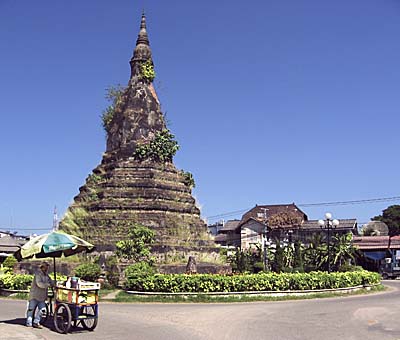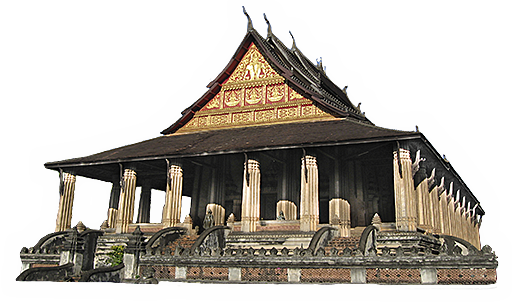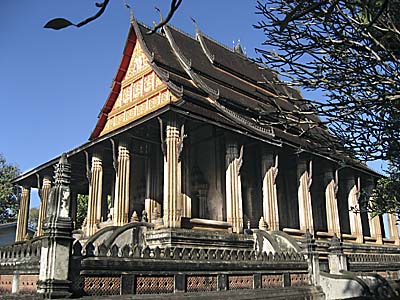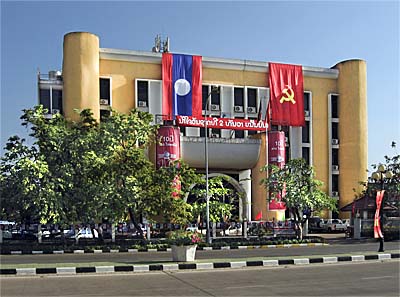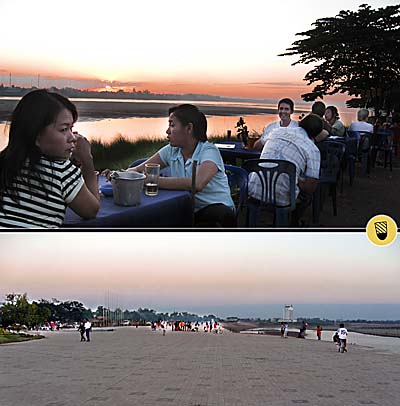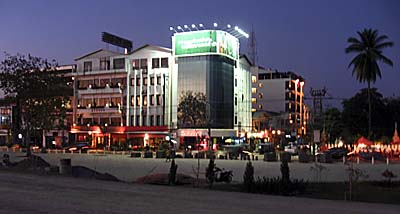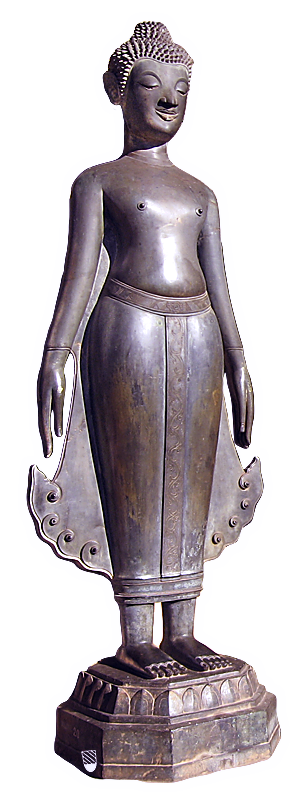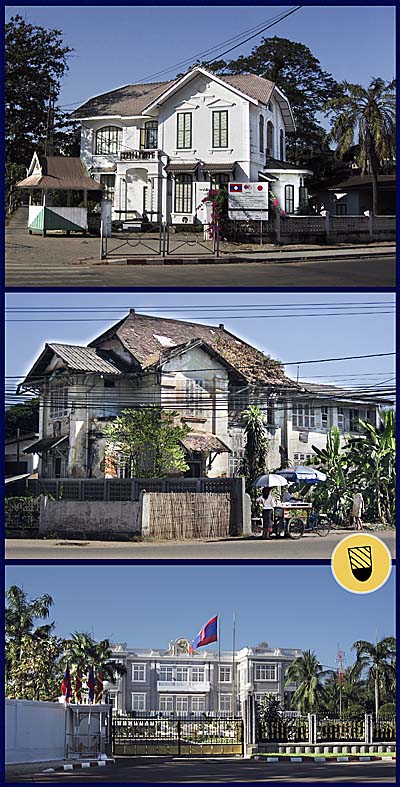
Strolling through the modernizing capital leads to the discovery of some smaller eyecandies. There is a number of old, colonial buildings in the city who look quite pretty. Some of them are (very nicely) restorated, others not yet.
The image below shows the presidential palace of Vientiane. The construction begun still in the American Vietnam War (1973), but wasn't finished when the Phatet Lao took power over. Since 1986 it's officially the residence of the president of Laos, but not the official home of the president. The presidential palace is not open for the public, but a landmark in Vientiane, close to the river and in direct neighbourhood to Wat Si Saket.
Images (2006) and photocomposition (2014) by Asienreisender.
There is not much of interest to visit in Vientiane. The reason to come here is often rather the fact that Vientiane is a traffic hub and a destination when coming from northeast Thailand on the way to north Laos. Moreover every day hundreds of western expats who live in Thailand have to perform their notorious and troublesome 'visa run'. The Thai consulate in Vientiane is a miserable place with long waiting-times and a really bad, stubbornly and extremely buerocratic organisation. Applicants even have to go there twice for their visa, because a stamp in a passport takes more than 24 hours.
Elsewise there are some, few more attractions mildly worth a visit. To absolve them is easily possible in a single day.
Pha That Luang is a 16th century old bombastic stupa and is counted as a national symbol for Laos. There are some legends about this sight. Allegedly the stupa contains a bone of the historical Buddha. Probably there was already a 13th century Khmer temple on the spot, marking the center of an earlier Khmer settlement. After the building became damaged twice it was restorated by the colonial authorities in the early 20th century.
Another remarkable and bulky building is Patouxay (victory gate, also: Patou Xai, Patuxay, Patousay, Patouxai, Patousai, Patusay, Patu Xay, Patou Xai, Patou Xay), which reminds to the Arc de Trioumphe in Paris, although the iconographies are oriental. With a height of 49 meters it's dominating the broad, representative Xang road. The concrete monster was designed in the 1960s as an independence memorial. Later the communist government reinvented the building as a memorial for the communist takeover in power 1975.
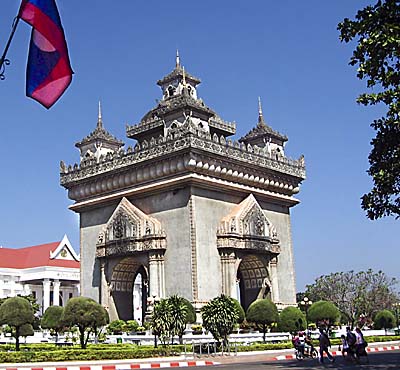
Patouxay, the bizarre independence monument of the kingdom of Laos, built after the French colonialists involuntarily left the country. It's remarkable to create such a memorial in a similar style of the central victory monument in Paris.
Image by Asienreisender, 2010
A much nicer sight is Wat Si Saket, built in around 1818 in order of king Anouvong (who was later executed in Bangkok). After Anouvong's war against Siam and the destruction of Vientiane, Wat Si Saket was spared by the Siamese. The reason might be that the temple's architecture is rather Siamese than Laotian. The French École française d’Extrême-Orient (French School of the Far-East) did a thorough restoration of the Wat in the 1930s. There is an attached museum in the charming old temple integrated.
On the other roadside opposite Wat Si Saket is Ho Pha Kaeo placed, another temple which is used as a museum nowadays. Originally this temple was constructed in the years around 1560 CE to house the famous emerald Buddha (Phra Kaeo) who is now in the royal palace in Bangkok. The famous Buddha statue, nowadays an important sight in Wat Phra Kaew in Bangkok, was taken by Siamese conquerers in 1779.
There is also a 'Lao National Museum' in town.

One of many bizarre and huge concrete sculptures in Buddha Park between Vientiane and the Friendship Bridge. Another of these Buddha Parks is some three kilometers outside Nong Khai.
Image by Asienreisender, 2006
No more inside Vientiane city but on the way to the Mekong bridge at Nong Khai is the bizarre 'Buddha Park'. It was created 1958 by Luang Pu Bunleua Sulilat, the same artist who later built a similar Buddha Park a bit outside of Nong Khai. Some see it as a sacred Buddhist place for many of the gigantic statues there are of Buddhist kind or elsewise variations of temple figures. Others see it as 'Monster Park', for the overdimensioned concrete statues mostly look quite distorted and show scaring face expressions.
On the way to the Buddha Park one passes also the very famous Beerlao brewery which is situated at the left roadside. So far I know it's possible to arrange a visitor date in the brewery. Imagine a day dedicated to one of the best beers of Southeast Asia, in existence since 1973. Beerlao might be the biggest Laotian company: in 2006 it was the biggest taxpayer in the country (drinking beer for socialism!). In 2008 another branch of the brewery was opened in Champasak (Pakse, south Laos) to satisfy the rising demand. Although the taste is fine, it's a bit sour, though, and can trouble the stomach. Anyway, as a beer-drinker one can not escape Beerlao in Laos: it has an omnipresent market share of more than 98%, due to high import taxes for foreign beers. Cheers!
Nowadays the LBC (Lao Brewery Company) is owned by 49% by the Laotian state; 51% are mixed between Thai and Italian investors and Carlsberg brewery, who joined the business later.
